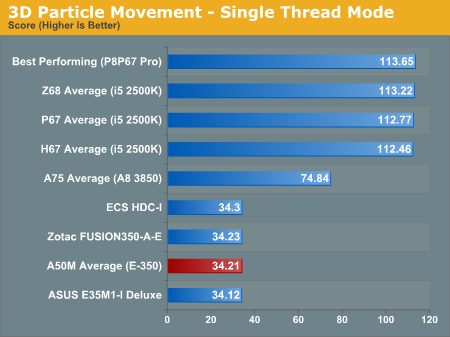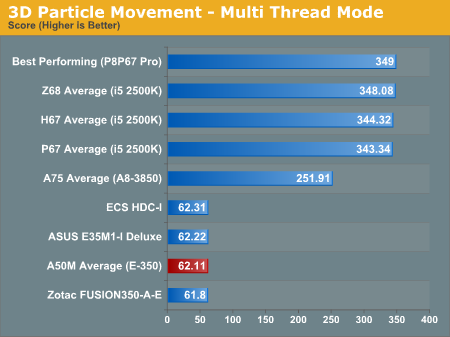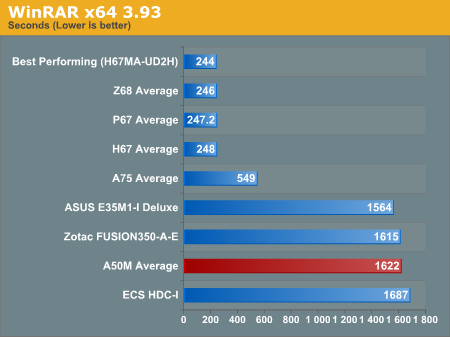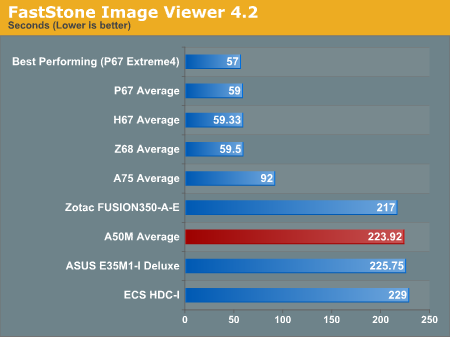Fusion E-350 Review: ASUS E35M1-I Deluxe, ECS HDC-I and Zotac FUSION350-A-E
by Ian Cutress on July 14, 2011 11:00 AM EST3D Movement Algorithm Test
This first benchmark uses various algorithms for three-dimensional simulation and movement of independent particles. The algorithms both employ uniform random number generation or normal distribution random number generation, and vary in various amounts of trigonometric operations, conditional statements, generation and rejection, fused operations, etc. The benchmark runs through six algorithms for a specified number of particles and steps, and calculates the speed of each algorithm, then sums them all for a final score. This is an example of a real world situation that a computational scientist may find themselves in, rather than a pure synthetic benchmark. The benchmark is also parallel between particles simulated, and we test the single thread performance as well as the multi-threaded performance.

There's not much to separate the Fusion boards here, but the lack of CPU power against higher performing parts is fairly obvious.

These results for the multithreading show a similar situation, however the Fusion boards also lose out here, as they are dual core whereas the others are quad core.
WinRAR x64 3.93
With 64-bit WinRAR, we compress the set of files used in the USB speed tests. WinRAR x64 3.93 attempts to use multithreading when possible.

FastStone Image Viewer 4.2
FastStone Image Viewer is a free piece of software I have been using for quite a few years now. It allows quick viewing of flat images, as well as resizing, changing color depth, adding simple text or simple filters. It also has a bulk image conversion tool, which we use here. The software currently operates only in single-thread mode, which should change in later versions of the software. For this test, we convert a series of 170 files, of various resolutions, dimensions and types (of a total size of 163MB), all to the .gif format of 640x480 dimensions.











67 Comments
View All Comments
CZroe - Saturday, July 16, 2011 - link
Regarding the Asus board not having HDMI1.4, you never seem to confirm that the others do or don't. have it. Should I assume they do or don't?"...and a Wifi card with a pair of antenna"
Antennae is the plural of "antenna." ;)
You wonder about the VGA reference in the Asus board's BIOS, but other boards clearly include a DVI to VGA adapter. Even if the Asus board doesn't include it, it could be referring to that unless it is DVI-D only. Does it support a VGA adapter?
"how overclocking effects gaming"
"Effects" should be affects.
Akdor 1154 - Saturday, July 16, 2011 - link
Given these boards are clearly pushed at the HTPC usage scenario (HDMI, TOSLINK optical outputs, one of the most powerful onboard GPUs ever made, passive cooling, etc) it is very disappointing to not see any of this functionality tested out.How did they perform decoding video? Given the high CPU usage on network utilization, is there any issue playing high bitrate content from a NAS somewhere else? Can I encode? How did the GPU perform on OpenCL tasks (namely, again, content encoding)? Can the PCI-E slot take a TV tuner? What about Flash, if only for Youtube? How about upscaling low-resolution content?
And for the love of God, given two passive and one active cooling setups, how did they fare in a REAL case? Don't know many people who run their HTPCs in open-air, and the nice small cases available can be quite restrictive in terms of airflow - so will the passively cooled boards even be suitable for these? How about fan noise? It would seem Zotac and ASUS went passive because of noise concerns, so how bad was the ECS's little 40mm fan?
What about WiFi performance? You complained about one only supporting HDMI 1.3b; did the others support 1.4 (and hence 3D) perfectly? Did you test this? There was an issue with Windows' audio buffer latency - it would have been great to see this actually tested out to see if it made any difference, instead of a vague "some people might be able to hear it". Did the problematic board skip at all?
Summing up the lack of insight in the way this review was carried out.. <b>did you even test Blu-Ray playback</b>?
I'd love to see this information added to this review - I'd also be interested to know how many people you think would purchase this intending to run Metro 2033 on it.
And finally it seems your comment form is broken in Opera.
evolucion8 - Sunday, July 17, 2011 - link
And the odd thing is when they were testing its IGP performance with Metro 2033, calling it "the Crysis of DX11 until Crysis 2 arrives, so Crysis 2 haven't been released yet? Mishmash of old and new sentences of old articles glued together. Pretty much the same thing that apoppin does on Allienbabletech and his horrible lack of focus and handbacked marketing propagandism.Plus the fact that the review has a lack of objectivity as it isnt compared to its direct rival the Atom/ION combination. I wonder who will stick a GTX 580, play games or will use it for WinRaR archiving. Atom and Fusion aren't powerhouses, are CPU's for very basic stuff and HTPC and they would had done tests in that arena, like web browsing tests, movie playback, Flash tests, USB and HD performance etc. Totally irrelevant, how low can this go?! Definitively one of the worst reviews I've ever seen.
Overall, a HTPC oriented system tested with unconventional tests against much more expensive and powerful solutions. It is like taking a Ferrari and test its performance under water and in outerspace and comparing it against the Columbia Shuttle and Navy's Nuclear Submarine. Things had gone under spiral lately and integrity has been long gone in here, a pity.
PR3ACH3R - Sunday, July 17, 2011 - link
@ Ian CutressThanks for the review,
I think you touched upon a few important points like thermal performance, but as a whole, this review leaves a lot to be desired.
it is incomplete, & fails to address what the target audience of these products, wants to know.
Did this review help me decide what board to buy for HTPC use?
I'm afraid not.
Ichinisan - Sunday, July 31, 2011 - link
It's pretty clear why the Asus BIOS mentions "VGA." The Asus and Zotac boards have DVI-I connectors, so they have extra pins for analog and work with a VGA adapters.dakky21 - Saturday, November 5, 2011 - link
I registered on this board just to say that... not ALL boards have overclock function !!!!I just bought HDC-I v1.0 yesterday, in fact only because I read it had overclock option, but what a cold shower - it does not have. At least not where it should be, under Frequency/Voltage control in BIOS.
dakky21 - Sunday, November 6, 2011 - link
To clarify, my board has BIOS version 2.10.1208 (03/24/2011) and there is NO Turbo Mode in Frequency/Voltage control. No way of getting around 33% more speed. Unfortunately, I bought this board just because of that. Never again trust reviewers or ECS...